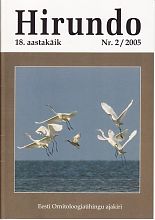Hirundo 2/2005
Ellermaa, M.
Breeding densities of common breeding species in managed mixed and moist forests in Pärnumaa, Estonia
PDF
Ots, M. & Klein, A.
Rarities in Estonia 2003-2004: Report of the Estonian Rarities Committee
Summary: This fifth report of the Estonian Rarities Committee covers the years 2003-2004, but some earlier records have also been included. Altogether 214 records were definitely assessed (Table 1), and 192 (90%) of these were accepted. The records are listed in systematic order (according to the new recommendations of AERC) and presented chronologically. Records of birds of unclear origin, escapees from captivity, corrections and changes, records not accepted, and records formerly accepted but now rejected are listed separately from the main list of accepted records. The four numbers in brackets after species’ name (a/b – c/d) indicate (a) the total number of records before 2003, (b) the number of individuals (if possible to judge) before 2003; © the number of records in 2003-2004, (d) the number of individuals in 2003-2004. X instead of a number means unknown number of records or individuals. The details included for each record are: date(s), locality, parish (khk.), district, number of individuals (is., isend), pairs (♂♀), nests (pesa) etc. if more than one, sex and age (if known; a = calendar year) and names of observers. The meaning of some Estonian terms and expressions: ja = and, läh. = near, jv. = lake, s. = island, laht = bay, (tõenäoliselt) sama isend = (probably) the same individual, pesitsemine = breeding. In 2003-2004, 6 new species in an apparently wild state (AERC category A) were added to the Estonian list: in 2003 Anas carolinensis, Calonectris diomedea and Emberiza melanocephala, in 2004 Hirundo daurica, Oenanthe pleschanka and Hippolais pallida. The race Motacilla alba yarrellii was recorded for the first time in Estonia in 1997 but accepted during the reporting period. Also one species of unclear origin (category D) – Lophodytes cucullatus and two species of category E (escapees from captivity) – Anser rossii and Anas cyanoptera – were recorded for the first time in 2003 in Estonia. In the same period, the breeding of Ficedula albicollis in Estonia was confirmed. Altogether, 350 species of apparently wild state or released species which have established self-supporting breeding populations in Estonia or in neighbouring countries (i.e. categories A-C) and 6 species of unclear origin (category D) have been recorded in Estonia by 31.12.2005
Notes (in Estonian)
Jürgens, M. On the vocal mimetic ability of common redstart
Ellermaa, M. Some observations of albinistic and melanistic birds
Bird conservation news, EOS chronicle and news (in Estonian)

